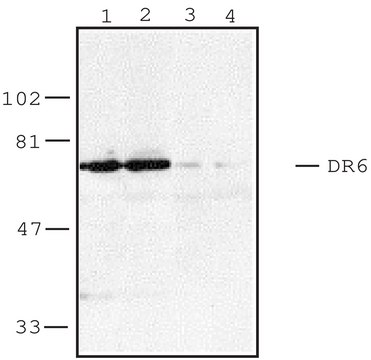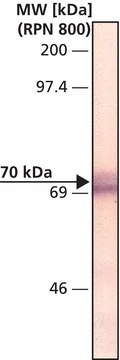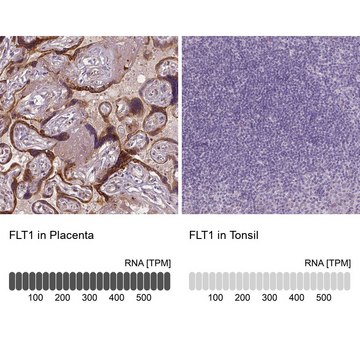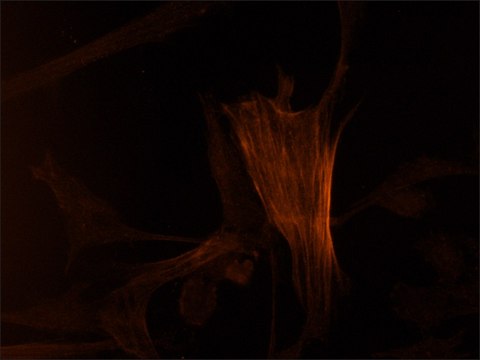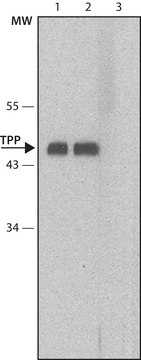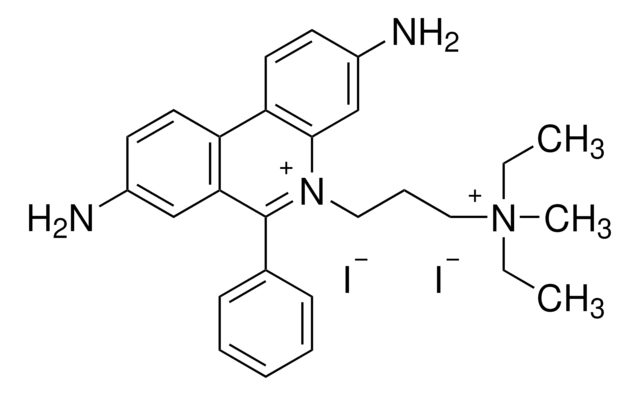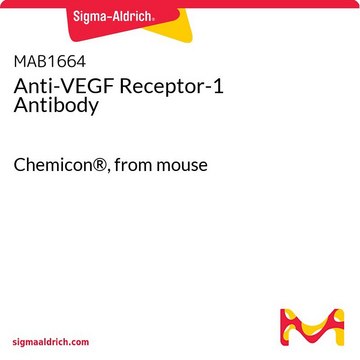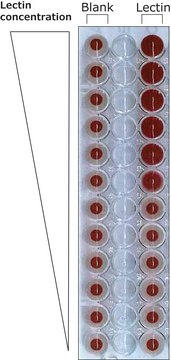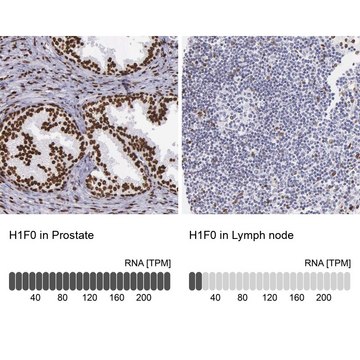推荐产品
生物来源
mouse
质量水平
偶联物
unconjugated
抗体形式
tissue culture supernatant
抗体产品类型
primary antibodies
克隆
FLT-19, monoclonal
包含
15 mM sodium azide
种属反应性
human
技术
immunohistochemistry (frozen sections): 1:100 using human placenta
immunoprecipitation (IP): suitable
indirect ELISA: suitable
microarray: suitable
同位素/亚型
IgG1
UniProt登记号
运输
dry ice
储存温度
−20°C
靶向翻译后修饰
unmodified
基因信息
human ... FLT1(2321)
一般描述
Monoclonal Anti-VEGF Receptor-1 (Flt1 Receptor) (mouse IgG1 isotype) is derived from the FLT-19 hybridoma produced by the fusion of mouse myeloma cells and splenocytes from BALB/c mice immunized with a recombinant extracellular domain of VEGF Receptor-1 (Flt1 Receptor) of human origin. Vascular endothelial growth factor (VEGF), also called vasculotropin (VAS)1 and vascular permeability factor (VPF) 2 is a member of a family of endothelial cell mitogens and angiogenic factors. VEGF is a homodimeric heparin-binding glycoprotein. VEGF binds to two structurally similar receptor tyrosine kinases; Flt15 (fms-like tyrosine kinase 1, also termed VEGF Receptor-1, VEGF-R1) and KDR6 (kinase-insert domain containing receptor, also termed VEGF-R2). Flt1 is predominately expressed in human placenta and human vascular endothelial cells, while KDR is more widely expressed in all vessel-derived endothelial cells but low in human and fetal bovine placenta.
Mouse monoclonal clone FLT-19 anti-Vascular Endothelial Growth Factor Receptor-1 antibody recognizes the extracellular domain of human VEGF Receptor-1 molecule (Flt1 Receptor). The antibody does not recognize VEGF Receptor-2 (KDR), VEGF receptor-3 (sFlt4,) and PDGF-Rβ.
免疫原
recombinant human extracellular domain of VEGFR-1.
应用
Monoclonal Anti-Vascular Endothelial Growth Factor Receptor-1 antibody produced in mouse has been used in:
- immunofluorescence labelling
- enzyme-linked immunosorbent assay (ELISA)
- immunohistochemistry
- immunoprecipitation
Mouse monoclonal clone FLT-19 anti-Vascular Endothelial Growth Factor Receptor-1 antibody may be used for the localization of VEGF-R1 using various immunochemical assays such as ELISA, immunoblotting, immunocytochemistry, immunohistochemistry, and immunoprecipitation. Antibodies that react specifically with VEGF receptors are useful for the study of the specific differential tissue expression and intracellular localization of the receptor in normal and neoplastic tissue.
生化/生理作用
The mitogenic activity of VEGF appears to be stimulated by specific VEGF receptors (160-200 kDa) which can be found on the surface of various endothelial cells. VEGF binds to two structurally similar receptor tyrosine kinases; Flt1 (fms-like tyrosine kinase 1, also known as VEGF Receptor-1 (VEGF-R1), and KDR (kinase insert domain containing receptor, also known as VEGF-R2). Studies using KDR and Flt1 stably transfected endothelial cell lines have shown that these two receptors exhibit different affinities to VEGF and mediate different responses. KDR/Flk1 does not respond to placental growth factor (PlGF), a VEGF related growth factor, while Flt1 binds PlGF specifically. Flt1 is predominately expressed in human placenta and human vascular endothelial cells. Both VEGF receptors (KDR and Flt1) are upregulated in human fetal and adult kidney.
Vascular endothelial growth factor (VEGF) stimulates the proliferation of endothelial cells isolated from both small and large vessels.
免责声明
Unless otherwise stated in our catalog or other company documentation accompanying the product(s), our products are intended for research use only and are not to be used for any other purpose, which includes but is not limited to, unauthorized commercial uses, in vitro diagnostic uses, ex vivo or in vivo therapeutic uses or any type of consumption or application to humans or animals.
未找到合适的产品?
试试我们的产品选型工具.
警示用语:
Warning
危险声明
预防措施声明
危险分类
STOT RE 2
储存分类代码
10 - Combustible liquids
WGK
WGK 3
法规信息
新产品
历史批次信息供参考:
分析证书(COA)
Lot/Batch Number
Sophie Le Ricousse-Roussanne et al.
Cardiovascular research, 62(1), 176-184 (2004-03-17)
Recent studies have provided increasing evidence that postnatal neovascularization does not rely exclusively on sprouting of preexisting vessels, but also involves bone marrow-derived circulating endothelial precursors (BM-EPCs). Animal studies revealed that neovascularization of ischemic tissue can be enhanced by BM-EPCs
Real-time ligand binding of fluorescent VEGF-A isoforms that discriminate between VEGFR2 and NRP1 in living cells
PeachnCJ, et al.
Cell Chemical Biology, 25(10), 1208- 1218 (2018)
Vascular endothelial cell growth factor (VEGF), an emerging target for cancer chemotherapy
Shinkaruk S, et al.
Current Medicinal Chemistry. Anticancer Agents, 3(2), 95-117 (2003)
A Sawano et al.
Blood, 97(3), 785-791 (2001-02-07)
Flt-1, also known as vascular endothelial growth factor receptor 1 (VEGFR-1), is a high-affinity tyrosine kinase receptor for VEGF and is expressed almost exclusively on vascular endothelial cells. As an exception, Flt-1 transcript was recently found to be expressed in
Chloe J Peach et al.
Cell chemical biology, 25(10), 1208-1218 (2018-07-31)
Fluorescent VEGF-A isoforms have been evaluated for their ability to discriminate between VEGFR2 and NRP1 in real-time ligand binding studies in live cells using BRET. To enable this, we synthesized single-site (N-terminal cysteine) labeled versions of VEGF165a, VEGF165b, and VEGF121a.
我们的科学家团队拥有各种研究领域经验,包括生命科学、材料科学、化学合成、色谱、分析及许多其他领域.
联系技术服务部门